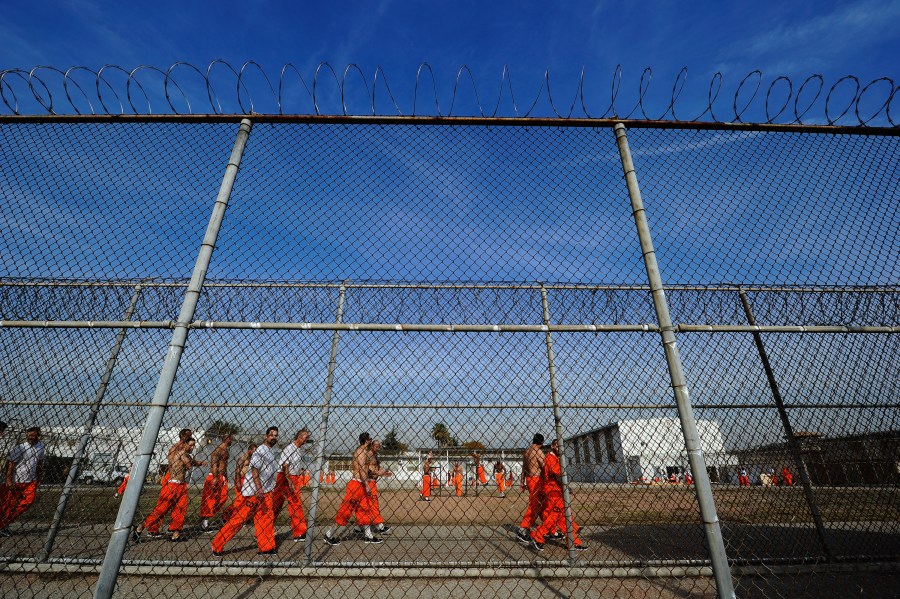Attorneys representing California inmates late Wednesday filed an emergency motion asking federal judges to free thousands of infirm and lower-security prisoners to prevent what they predict will otherwise be the catastrophic spread of coronavirus through a vulnerable population.
They want the judges to order the release of inmates who are at higher risk for complications from the disease, as well as nonviolent offenders who are within a year of being paroled.
So far, one inmate and nine employees have tested positive. But every day without action is “another lost opportunity to mitigate the effects of what we know is going to be a severe calamity,” said Don Specter, director of the nonprofit Prison Law Office and one of the attorneys filing the request.
The state Department of Corrections and Rehabilitation said it will be reviewing the action and already has taken measures such as halting public prison visits and screening everyone who enters a facility.
“Public safety is a top priority for CDCR, as is the health of our community,” said a statement from the department.
Gov. Gavin Newsom on Tuesday ended transfers into state prisons from county jails for 30 days, an order expected to reduce the population by more than 5,000 inmates. But he ruled out the release of violent offenders and said he fears other wholesale releases would add to problems in already strained community hospitals and homeless shelters.
The inmates’ attorneys filed their motion with a panel of three federal judges who a decade ago ordered the state to dramatically reduce its prison population to improve living conditions. That order reduced the population in what once was the nation’s largest state prison system, with about 170,000 inmates, to the current 123,000 convicts.
Only such a three-judge panel can order inmate releases, under federal law.
“We’ve already released too many prisoners from state prison (in response to the judges’ previous order). The low hanging fruit has already been picked. The people who are in prison need to be there,” said Kent Scheidegger, legal director for the Criminal Justice Legal Foundation that backs crime victims’ rights. The court filing, he said, “certainly seems to be (a case of) ‘never waste a good crisis.’”
Christine Ward, executive director of the Crime Victims Action Alliance, said it is important to keep inmates safe, but “we have serious concern about letting people out of prison early that could potentially come into our communities and cause harm.”
The attorneys are asking the judges to release those whom corrections officials have already been deemed to be low risks to public safety, are serving time for nonviolent offenses and are scheduled to be paroled within the year. California narrowly defines violent offenses to include 23 crimes like murder, rape, kidnapping and felonies in which a gun is used or that causes great bodily injury.
The goal is mainly to free up space in crowded dormitories that house more than 46,000 inmates, or nearly 40% of the population. There often are dozens of inmates double-bunked with little space to maintain the 6 feet of separation that health officials advise, their filing says.
The state’s current plan includes potentially housing sick and healthy inmates in the same dorm, separated by a line of tape on the floor “to mark the isolation section,” the motion says.
They also want judges to release inmates with health conditions listed as vulnerable by the U.S. Centers for Disease Control and Prevention.
Those include more than 5,000 inmates age 65 and up, along with prisoners with chronic lung disease, moderate to severe asthma, heart disease with complications, compromised immune systems, severe obesity, uncontrolled diabetes, renal failure, liver disease, or those who are pregnant.
More than 17,000 inmates, or 15% of the prison population, are classified as medically high risk, according to the court filing. It quotes Clark Kelso, the federal receiver who controls healthcare in California prisons, as supporting an accelerated release program to allow for social distancing.
Specter says it is unclear how many would be released if the judges agree. But he and other attorneys have talked in terms of releasing at least 10,000 inmates.
“I think everyone sees that density needs to be reduced, that it’s a public health emergency and there are people who are safe and appropriate to be placed in the community,” said Michael Bien, another attorney representing inmates’ interests.
About 36,000 inmates are paroled each year from California prisons, and many end up homeless, Specter said. It was nearly 38,000 in the last 12 months, state figures show.
“Adding another 10,000 or even 20,000 to the number of people who are paroled who are going to get out in a year anyway doesn’t seem like it would have a significant impact on the governor’s ability to deal with this crisis,” Specter argued. “And it would save innumerable lives, because once the virus starts spreading in the prisons it could have catastrophic effects.”
